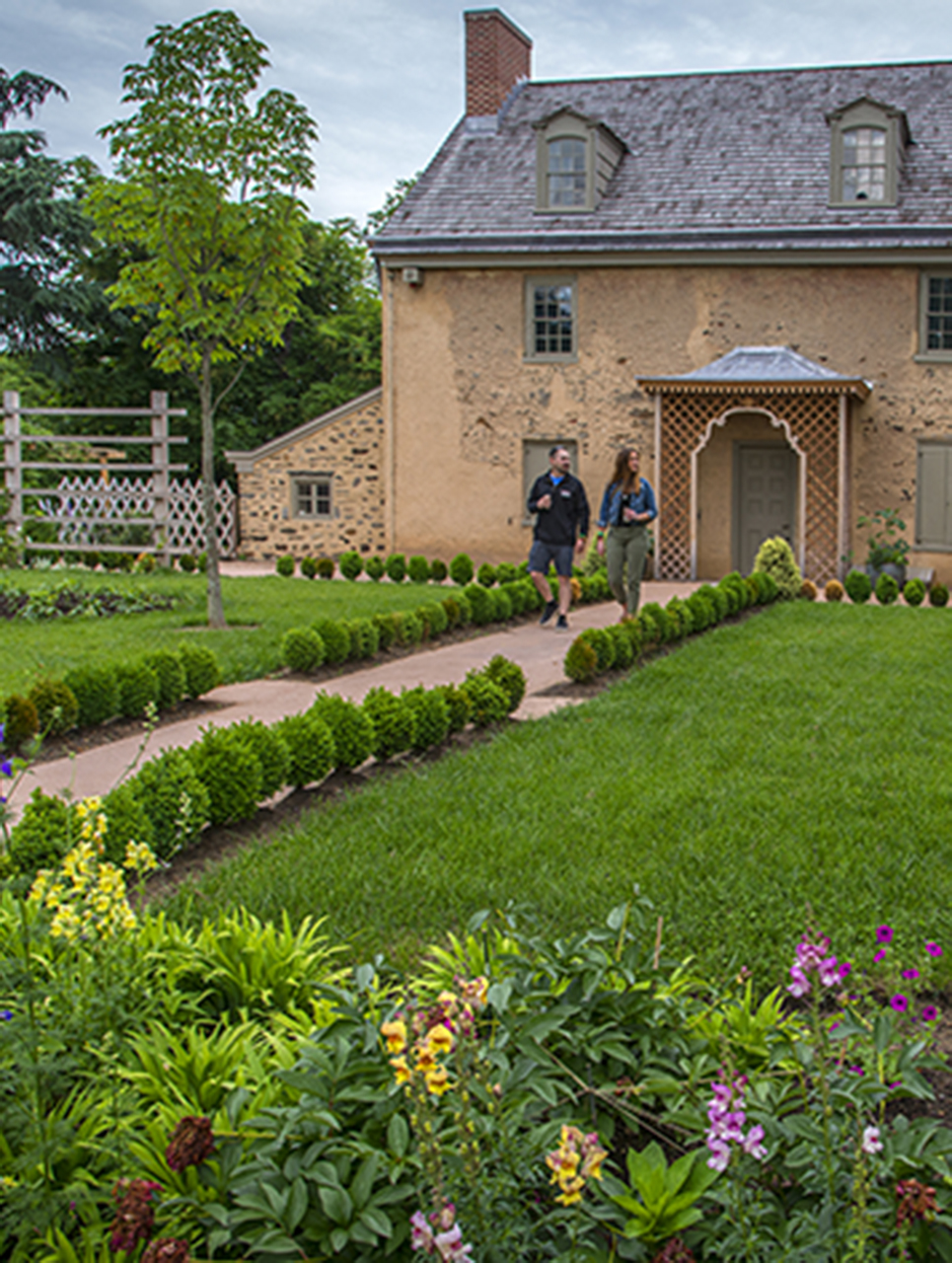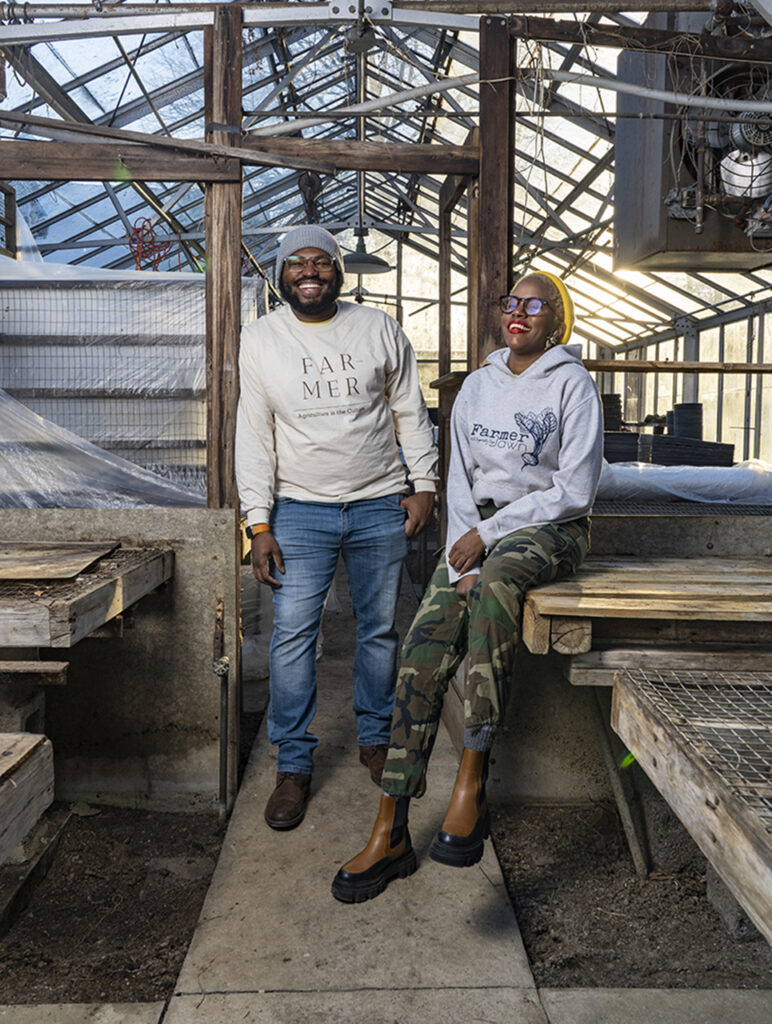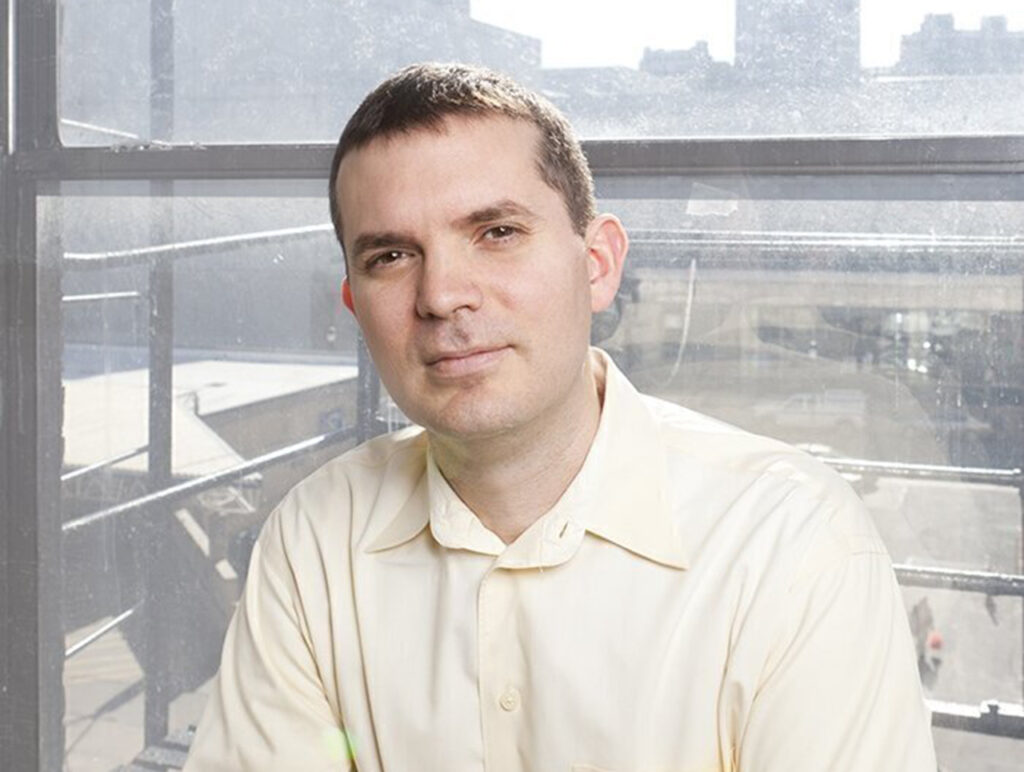It’s been just over six years since Bartram’s Garden made the switch to geothermal heating and cooling, using ground source heat pumps (or GSHP) to heat the public garden’s 18th century buildings. By drilling deep into the ground, geothermal systems tap into heat that is stored in the earth. It greatly reduces the need for fossil fuels.
The GSHP installation took place as part of restoration work to the Bartram House and Carr Garden. Prior to this, most of the buildings were utilizing traditional HVAC systems, which use electric resistant heat strips, gas furnaces and condensers to heat or cool air. The stone house, which John Bartram began building in 1728, was heated with an oil furnace until 2015 when the oil infrastructure was removed.
Tom Reber, director of landscapes and facilities at Bartram’s, says the garden’s goals in switching to geothermal were to reduce energy consumption, achieve a quieter and cleaner landscape and reduce the site’s internal HVAC maintenance needs.
“While we don’t know the exact reduction on the utility bill here [because utilities are billed to the City of Philadelphia] we do know that it has absolutely reduced our utility cost for the historic buildings, as the heat pumps are more energy efficient and we are no longer heating with fuel oil,” Reber says. “Maintenance has shifted from relying heavily on compressor and boiler maintenance to cleaning strainers for the geothermal water loops, monitoring the system pressure and maintaining our monthly duct filter change outs.”
He also points out that GSHP has allowed for the garden to ditch the large and noisy compressors that once took up space in the garden itself, avoid weather-related maintenance issues and reduce pressure on the landscape previously applied by trucks and repair people accessing the previous systems.
“The result is a more vibrant, healthy and historically accurate Bartram’s,” he says.
For Emily Davis, a core member of the Sierra Club’s Southeastern Pennsylvania Group, stories like the one Reber tells inspire her to think big—to push more parks, businesses and homeowners to consider GSHP as a greener, more cost-effective way to heat and cool buildings.
Many people think geothermal is still a very new technology, so our focus is raising awareness and education.”
— Mehdi Entezari, founding member of Geodelphia
Davis is a founding member of Geodelphia, an organization of volunteers and experts dedicated to researching and promoting geothermal energy. The group’s members meet every second and fourth Tuesday of the month via Zoom to discuss goals and support each other’s efforts.
The group emphasizes that the technology has been in use for at least 40 years.
“Many people think geothermal is still a very new technology, so our focus is raising awareness and education,” says Mehdi Entezari, another Geodelphia founding member.
Using GSHP, people run water pipes underground and send them through heat pumps to warm indoor air in the winter and cool it in the summer.
“Most of the energy needed to do this is going unused, ten feet or so underground. [It’s] solar energy stored in the earth. Run some pipes down there, add a small amount of power to run the heat pump and you get practically free heating and cooling,” Geodelphia’s website states.
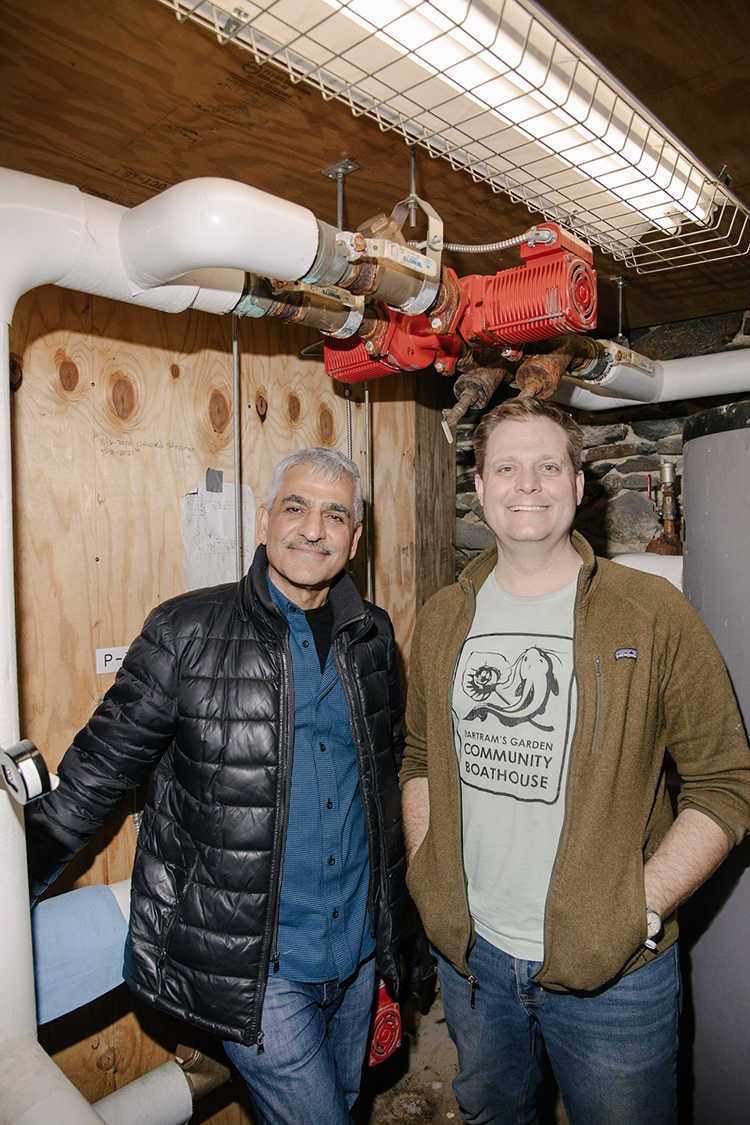
The GSHP process, while colloquially known as “geothermal,” is quite different from the conventional geothermal systems, which use naturally occurring hot water or steam flows that are heated by volcanic systems in areas with active or young volcanoes.
As the Pennsylvania Department of Environmental Protection (DEP) points out, “there are no known conventional geothermal resources suitable for power production in Pennsylvania.”
These pipes serve as the main supply and return for water going between the geothermal wells and the red heat pumps.
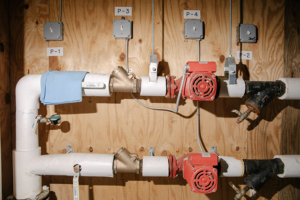
“However,” the DEP continues, “there are suitable conditions for the use of energy efficient ground source heat pump technology, also referred to as ‘Geoexchange’ and geothermal heat pump.”
And these systems don’t require much space.
“You don’t need lots of land for GSHP,” the DEP explains, “it is dependent on your needed tonnage of heating and cooling.”
The state agency notes that commercial buildings, classrooms and dorms could benefit from the energy savings the system offers.
In Philadelphia, where 60% of the city’s carbon footprint comes from heating and cooling homes and buildings, replacing our HVAC systems with geothermal would reduce our emissions significantly.
“A main goal is getting geothermal cooling and heating systems into the schools, companies and municipal buildings owned by the local government,” Entezari explains.
To members of Geodelphia, there’s another compelling reason to consider GSHP. According to Davis, once you become aware of it, it’s hard not to think about.
A recent study measuring natural gas leaks across Philadelphia shows danger lurking just below the city’s surface. Davis says she was horrified by the report, which revealed 1,001 gas leaks from pipes that deliver natural gas to buildings for heat, cooling, cooking and laundry throughout the city.
“I was flabbergasted by how many [leaks] there are, how big they are and how close many of them are to schools,” Davis says. And the study was by no means comprehensive—it only surveyed about 10% of the city.
It was commissioned by volunteers from the Southeastern PA Sierra Club, after they connected with Gas Safety USA, which had mapped gas leaks in Boston a few years ago.
As Meenal Raval explains in a blog post for the Sierra Club about the study, the initial mapping was meant to demonstrate the overall scope of the gas leak problem, in hopes of raising public concern about the leaks.
“Ideally this initial mapping will build demand and resources ($100,000 goal) for a subsequent street-by-street mapping of the entire city, which could be used to more confidently pinpoint areas of the city that have the highest leakage,” Raval says. “The initial sponsors of this study want the results to influence PGW’s [Philadelphia Gas Works] leak prioritization plans.”
Currently, PGW’s timeline to fix the pipes causing the leak would span the next few decades.
“PGW anticipates that all of its unprotected steel service lines and cast iron mains will be replaced by 2038 and 2058, respectively,” PGW explained in a June 2021 post.
There are an estimated 1,230 miles of natural gas pipes beneath Philadelphia that connect to homes and businesses.
At least 50% of these natural gas mains are estimated to be cast iron, a material that easily rusts and deteriorates, allowing leaks to occur. It is no longer used in new gas main installations.
Raval warns that there could be deadly consequences, like the 2019 explosion that killed two people and destroyed three row homes in South Philly, which was linked to a natural gas pipe leak.
“Gas leaks in the distribution pipes within our city could lead to, and have led to, explosions, making urban areas quite unsafe,” Raval writes.
She adds that the gas leaks are also contributing to climate change.
“Gas in the pipes coming into our homes is indeed methane. Methane is a potent greenhouse gas, contributing more than 80 times the warming potential of carbon dioxide over a 20-year period, says the National Resources Defense Council and many others,” Raval writes. “And, the fact that it’s wasted, not even used by anyone is outrageous.”
As the full scope of the problem is not yet known, Davis agrees more funding is necessary.
Without funding, and without a larger study of the leaks, it could be tough to convince the city and its home and business owners to invest financially in making the switch to something more sustainable.
And that’s where the work begins.
Entezari explains that a big part of that is getting the business model in front of PGW, the natural gas company owned by the City of Philadelphia.
“We want to say to PGW, that what they’re doing is providing a service. If you own the geothermal system in the homes, then they can charge for the [energy] they provide … [T]hat becomes another source of revenue. And it’s good for the union workers too because now they can begin being involved in building these geothermal systems. So that’s our other goal,” Entezari says.
Published in December 2021, a Philadelphia’s Office of Sustainability study aimed to better understand how PGW could diversify its energy sources and work toward a lower-carbon future. One of the pathways it identified was building more geothermal heating systems. However, the study noted concerns about the costs.
…I believe it has also made us more attuned to the living, breathing nature of our historic buildings…”
— Tom Reber, director of landscapes and facilities at Bartram’s Garden
“Networked geothermal systems, if owned and operated by PGW, may provide a diversification option for PGW, but this solution is likely to require significant capital investments and regulatory analysis; more study is needed to assess the exact costs and feasibility of the concept in Philadelphia,” the study says.
On average, HomeGuide.com notes installation costs anywhere from $15,000 to $35,000 for a complete system.
For Bartram’s Garden, the GSHP system cost around $500,000 according to Reber, who notes the park’s buildings likely required many more GSHP pumps than your average residence.
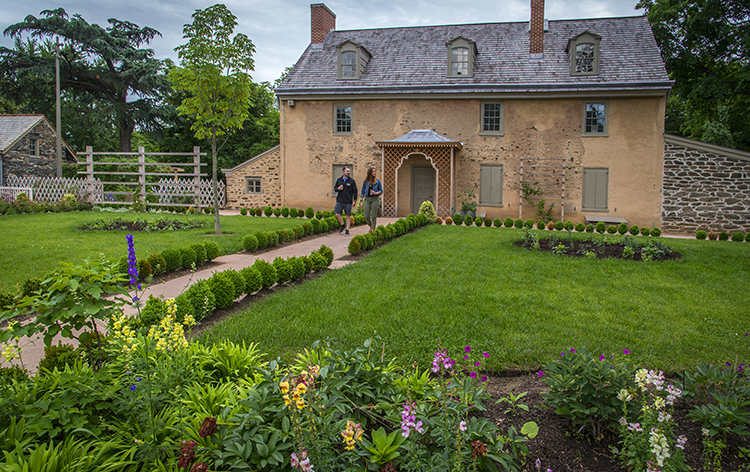
PGW’s involvement is essential to transforming the city into a clean-energy leader. According to Entezari, it’s better for everyone in the long run.
The DEP notes that the upfront cost of a GSHP system is typically more expensive than a traditional HVAC system “due to the additional heat exchange components.”
“The return on investment in savings often occurs within 5 to 10 years, but depends upon many factors such as the cost of energy, cost of system, installation costs and size of system,” the state writes. “These systems typically last 25 or more years.”
Geothermal-curious Philadelphians who own buildings and businesses have plenty of local examples to consider if they are interested in making the shift to a clean
energy source.
In 2019, the German Society of Pennsylvania, a 130-year-old building, upgraded its heating and cooling system to geothermal.
Construction of Kensington High School for the Creative & Performing Arts, which aimed to use less energy than any other school in the School District of Philadelphia, was completed in 2010 and implemented a geothermal heating and cooling system.
According to Reber, the process to drill wells and trenches for GSHP at Bartram’s took about four to five months. He says another month or two was needed after this to install the equipment.
He notes that the process did present some challenges considering the nature of the structures involved.
“ … [T]he site itself presented some unique issues in that the historic buildings sit on a 200-foot prehistoric sand dune and the boreholes were collapsing while drilling through that sand,” he says. “Ultimately we ended up casing all twelve wells, but it required additional specialized drilling equipment and crews—actually sent down from Alberta, Canada.”
The process of drilling and trenching is quite disruptive, he says.
“We also had a lot of drilling spoils and erosion and sediment controls to contend with during drilling—all of that material was hauled off-site and disposed of so as to not impact our soils,” Reber explains.
Jack DiEnna is another Geodelphia founding member and executive director of the Geothermal National and International Initiative, a nonprofit organization founded in 2019. He has an idea for how Philadelphia should kick off its GSHP transition.
“I propose that we start with the K through 12 schools. That way the students get to know about the technology, and the parents are ‘schooled’ by their kids,” DiEnna says.
He points to an elementary school on Long Island that switched over to a geothermal heat pump system with the help of his organization.
“I get at least five to six calls per month from parents of students at that school asking how they can install it in their home,” DiEnna says. “It proves that having the students be the ‘marketing team’ is the way to go.”
One last thing Reber likes to mention is how the implementation of the geothermal system has changed how people at Bartram’s connect to the heating and cooling most of us take for granted.
“It has required us all to rethink how we live and work in the buildings here,” Reber explains. “Geothermal responds to thermostat changes slowly, so gone are the days of tweaking the thermostat at every turn when it’s too hot or cold. That change was definitely evolutionary here, but I believe it has also made us more attuned to the living, breathing nature of our historic buildings and enabled us to be better stewards of them.”


